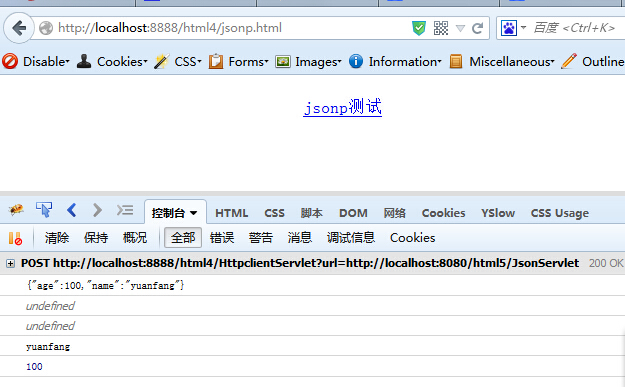最近接手一个项目,新项目需要调用老项目的接口,但是老项目和新项目不再同一个域名下,所以必须进行跨域调用了,但是老项目又不能进行任何修改,所以jsonp也无法解决了,于是想到了使用了Httpclient来进行服务端的“跨域”来替代jsonp的客户端跨域方案。
上一篇博文中,详细剖析了jsonp的跨域原理,本文使用Httpclient来替代jsonp的客户端跨域方案。
先去 http://hc.apache.org/downloads.cgi 下载最新版httpclient。解压tutorial文件夹中有html和PDF的使用介绍。
下面实现从8888端口的html4项目中跨域访问8080端口的html5项目中的JsonServlet:
1)在html4中建立一个中间代理servelt和一个工具类,工具类代码如下:
import java.io.IOException;
import java.io.OutputStream;
import org.apache.http.HttpEntity;
import org.apache.http.StatusLine;
import org.apache.http.client.ClientProtocolException;
import org.apache.http.client.HttpResponseException;
import org.apache.http.client.methods.CloseableHttpResponse;
import org.apache.http.client.methods.HttpPost;
import org.apache.http.impl.client.CloseableHttpClient;
import org.apache.http.impl.client.HttpClients;
public class HttpUtil
{
public static boolean returnResponseOfUrl(String url, OutputStream os)
{
CloseableHttpClient httpclient = HttpClients.createDefault();
HttpPost httpPost = new HttpPost(url);
CloseableHttpResponse response = null;
try{
response = httpclient.execute(httpPost);
StatusLine statusLine = response.getStatusLine();
HttpEntity entity = response.getEntity();
if(statusLine != null && statusLine.getStatusCode() >= 300){
throw new HttpResponseException(statusLine.getStatusCode(),
statusLine.getReasonPhrase());
}
if(entity == null){
throw new ClientProtocolException("response contains no content");
}
entity.writeTo(os);
return true;
}catch(IOException e){
e.printStackTrace();
return false;
}finally{
if(response != null){
try{
response.close();
}catch(IOException e){
e.printStackTrace();
}
}
}
}
}
中间代理servlet代码如下:
@WebServlet("/HttpclientServlet")
public class HttpclientServlet extends HttpServlet
{
private static final long serialVersionUID = 1L;
public HttpclientServlet()
{
super();
}
protected void doGet(HttpServletRequest request, HttpServletResponse response) throws ServletException, IOException
{
this.doPost(request, response);
}
protected void doPost(HttpServletRequest request, HttpServletResponse response) throws ServletException, IOException
{
String url = request.getParameter("url");
if(url != null){
if(!HttpUtil.returnResponseOfUrl(url, response.getOutputStream())){
if(!HttpUtil.returnResponseOfUrl(url, response.getOutputStream())){ // 如果出错,再试一次
// log.error("url:" + url);
};
}
}
}
}
html4项目中的访问页面代码如下:
<!doctype html>
<html>
<head>
<meta charset="utf-8">
<meta name="keywords" content="jsonp">
<meta name="description" content="jsonp">
<title>jsonp</title>
<style type="text/css">
*{margin:0;padding:0;}
div{width:600px;height:100px;margin:20px auto;}
</style>
</head>
<body>
<div>
<a href="javascript:;">jsonp测试</a>
</div>
<script type="text/javascript" src="js/jquery-1.11.1.js"></script>
<script type="text/javascript">
$(function(){
$("a").on("click", function(){
$.ajax({
type:"post",
url:"http://localhost:8888/html4/HttpclientServlet?url="+ecodeURIComponent("http://localhost:8080/html5/JsonServlet"),
success:function(data) {
console.log(data);
console.log(data.name);
console.log(data.age);
var user = JSON.parse(data);
console.log(user.name);
console.log(user.age);
}
});
})
});
</script>
</body>
</html>
上面通过:url=http://localhost:8080/html5/JsonServlet 将我们最终要跨域访问的url地址传给自己服务器下的 HttpclientServlet. 然后在 HttpclientServlet 中使用httpclient访问 跨域 url 中的servlet,成功之后,将返回的结果返回给客户端。
html5项目中被 跨域 访问的servlet代码如下:
@WebServlet("/JsonServlet")
public class JsonServlet extends HttpServlet
{
private static final long serialVersionUID = 4335775212856826743L;
protected void doPost(HttpServletRequest request, HttpServletResponse response)
throws ServletException, IOException
{
User user = new User();
user.setName("yuanfang");
user.setAge(100);
Object obj = JSON.toJSON(user);
System.out.println(user); // com.tz.servlet.User@164ff87
System.out.println(obj); // {"age":100,"name":"yuanfang"}
response.getWriter().println(obj);
}
protected void doGet(HttpServletRequest request, HttpServletResponse response)
throws ServletException, IOException
{
this.doPost(request, response);
}
}
启动8888和8080端口的tomcat,访问 http://localhost:8888/html4/jsonp.html ,结果如下:

我们注意到第二和第三项都打印的是 undefined ,这是因为 中间代理的 HttpclientServlet,使用的是直接输出流的方式,所以最终返回的结果不是Json对象,而是字符串,所以需要使用 var user = JSON.parse(data); 来进行解析成 javascript对象就可以,所以第四和第五项都正常输出了结果。
如果想返回的是json对象,加一句代码 response.setContentType("text/json;charset=utf-8"); 就可以:
if(url != null){
response.setContentType("text/json;charset=utf-8");
if(!HttpUtil.returnResponseOfUrl(url, response.getOutputStream())){
if(!HttpUtil.returnResponseOfUrl(url, response.getOutputStream())){ // 如果出错,再试一次
// log.error("url:" + url);
};
}
}
这样的话,浏览器在看到 contentType: "text/json;charset=utf-8" 时,它的js执行引擎会自动帮助我们将字符串解析成json对象。也就是相当于自动调用了 JSON.parse(data) 的效果。
简单吧 ^__^





















 2948
2948











 被折叠的 条评论
为什么被折叠?
被折叠的 条评论
为什么被折叠?








